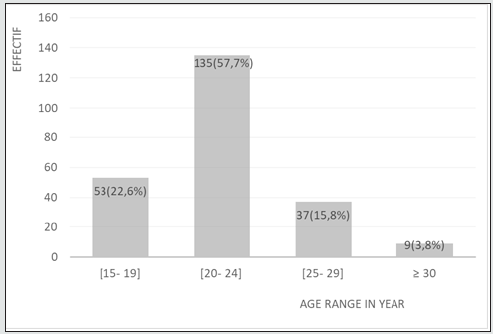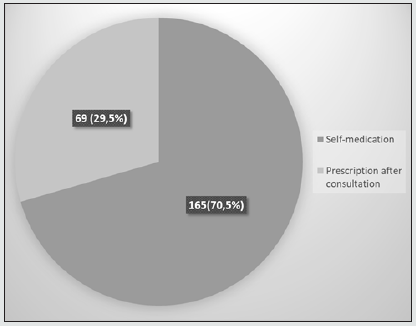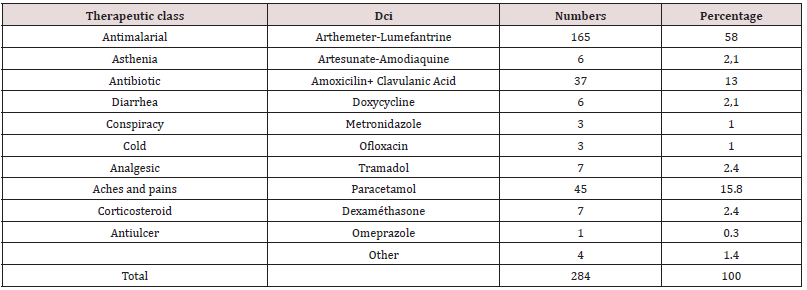
Lupine Publishers Group
Lupine Publishers
Menu
ISSN: 2644-1373
Research ArticleOpen Access
Profile of drugs used for prescription or not (selfmedication) by medical students Volume 2 - Issue 5
Kakou A*, kouassi JM, Daubret PT, Balayssac E, Gboignon VM, Yavo JC, Kamagaté M and Die-Kacou H
- Clinical Pharmacology Department Cocody University Abidjan, Côte d’Ivoire (West Africa), France
Received:September 14, 2021; Published:October 08, 2021
Corresponding author: Augustine Kakou, Department of Clinical Pharmacology University of Félix Houphouet-Boigny, Abidjan 04 BP 51 Abidjan 04 Ivory Coast Côte d’Ivoire, France
DOI: 10.32474/LOJPCR.2021.02.000150
Abstract
Introduction: Medical students trained in good practices and use of medicines [1] face the same accessibility problems as the general population, hence self-medication [2]. They can hardly see a doctor, and prescribed prescriptions are expensive for their meagre budget. Our aim was to study the profile of the drugs used by medical students as prescription and/or self-medication in order to identify the reasons, risks and adverse effects of their practices.
Materials and methods: This descriptive cross-sectional study took place from May 12 to June 14, 2019, involving medical students from the Preparatory School of Health Sciences (EPSS) and the UFR Medical Sciences in Abidjan (UFRSM).
Results: the average age of the students was 21.28 ± 4.7 years. The 20 to 24 age group represented 57.7% of the survey. 94.4% of the students were Ivorian, with 66.2% male (i.e., a sex ratio of 1.9). 38.5% of them were in License 2 and 19.2% in Master 1. The students lived for 38.5% of them with their parents, 34.2% alone and 27.4% in university residences.
On pathological point: The main reasons for prescribing were headaches, asthenia and fever respectively 46.6%, 27.8% and 27.8%. Common diagnoses were malaria (37.6%), influenza (17.1%) and typhoid fever (11.1%).
On prescribed point: prescribed drugs was used by the students in 29.5% of the cases while more than 70.5% self-medicated. The prescription was readable in 71.0%. The prescribed treatment was mostly on an outpatient basis (79.7%). The prescriber was a physician in 56.5% or a doctoral student in 26.1%.Only 65.5% of the students who practiced self-medication had knowledge of side effects. 97.4% of the students did not perform confirmatory paraclinical examinations before any treatment. The average cost of treatment with prescribed drugs was 10.323 fCFA and could reach 61.000 fCFA, while that of self-medication was 2.962 fCFA and did not exceed 25.000 fCFA.
Conclusion: Medical students use few prescription drugs, and self-medicate more because of treatment costs, a persistent source of the perennial problem of access to care.
Keywords: Prescription; Drugs; Self-Medication; Medical Students
Introduction
According to the definition of the WHO Pharmaceutical Dictionary [1] and that of the European Directive 65/65, a medicinal product is “any substance or composition having curative or preventive properties with regard to human diseases. Indeed, any substance or composition that can be administered to humans for the purpose of establishing a medical diagnosis or restoring, correcting or modifying physiological functions in humans is also considered a medicinal product [1]. However, the irrational or non-rational use of drugs (poly pharmacy, inappropriate) is a major global problem, often in inadequate dosages. These common practices are also seen with students. Thus, for Adlaf et al, the prevalence of illegal psychotropic drug use (excluding cannabis in Canada) has been estimated at 52% [2]. For Koudou, students from UFR of Bouaké, consumed at least one drug during the examination period by self-medication [3]. Although medical students are expected to have habit of good practices and use of medicines, they face the same problems of access to medicines as the general population. Our objective was to study the profile of the drugs used as prescription and/or self-medication by medical students in order to identify the reasons, risks and adverse effects of their practices.
Materials and Methods
This cross-sectional study with descriptive aim took place from May 12 to June 14, 2019, including 234 medical students from the Preparatory School of Health Sciences (EPSS) at Nangui Abrogoua University and the UFR Medical Sciences of Abidjan (UFRSM). All medical students enrolled, regardless of gender, after informed consent were submitted. Students absent during the study period were excluded. The results were analyzed with Epi info 7 software.
Results and Comments
The average age of students was 21.28 ± 4.7 years, with age variation between 15 and 33 years (Figure 1); similar to Koudou’s study on the consumption of psychostimulants (20.6 ± 2.7 years) [3] and into that of Normand et al. on the intellectual doping of pharmacy students during the examination period (21 years) [5]. Thus, students were particularly young in health sciences. Our study showed male predominance (66.2%) with sex ratio of 1.9 comparable to another study in which surroundings school and university regardless the levels of study, this sex ratio varies from 2 to 4 [6]. Most of the students in our study were in Bachelor 2 (38.5%) or Master 1 (19.2%) but they were more students in L1 (first year license) at Koudou [3]. 38.5% of these students lived with their parents, 34.2% alone and 27.4% on university campuses. While according to Koudou [3] 48.1% of students lived with parents. This difference could be explained by the larger number of students in the group 600 compared to 234 in our study. Pathological reasons for using the drugs were headache, asthenia and fever respectively 31.3%, 8.7%and 16% (Table 1). The diagnoses mentioned were first malaria (37.6%), then influenza (17.1%) and typhoid fever (11.1%). These students were self-diagnosing as a result of the knowledge acquired during the lectures, and/or internships. Our results are superimposed with those of the work of Valentin et al [7] on the prevalence and characteristics of self-medication among students aged 18 to 35 residing at the Kasapa Campus of the University of Lubumbashi.
As for drugs (prescribed or taken as self-medication), the most used were antimalarials (58%), antibiotics (13%), analgesics and antipyretics (15.8%), but also some corticosteroids and antiulcers (Table 2). These same drugs were found in Konaté’s study on self-medication in pharmacies in the city of Sikasso (Mali) [8]. Thus, 70.5% of these students practiced self-medication and only 29.5% received prescriptions (Figure 2). Self-medication is a practice to be combated because self-diagnosis and treatment can be a source of error. This tendency to self-medication has been found in Valentin et al [7] among health science students. Indeed, 45.1% of them admitted to using self-medication and 54.9% of students of other sciences. The prescription could be legible in 71% of cases. The prescribed treatment was as outpatient in 79.7% of cases. The prescriber was a doctor in 56.5% or a PhD student in 26.1% of cases.
These observations described are intended to promote habits of good prescribing. Indeed, the prescription obeys rules that must be respected and known in order to comply with the recommendations. Students who practiced self-medication 65.5% had knowledge about side effects but 34.5% knew nothing about what constituted a danger. Almost all (97.4%) of the students did not perform paraclinical examinations to confirm the diagnosis either probably due to negligence or lack of financial means. For illustration, the average cost of treatment by self-medication was 2,962 fCFA with extremes of 200 and 25,000 fCFA. While that of the prescription was 10,323 fCFA with extremes of 400 and 61,000 fCFA (Table 3). The important thing is that self-medication was less expensive than drugs prescribed by a doctor. Some African studies [8, 9] have recognized that it is due to poverty, counterfeit medicines in the market [4], the proliferation of prescribers in our centers as well as the inaccessibility to doctors in our structures. Finally, the limitations of this work could be information biases. Indeed, some students refrained from answering questions when others were limited in understanding the questionnaire.
Conclusion
Medical students use few prescription drugs, and practice more self-medication because of the costs of treatment, hence the eternal problem of accessibility to care. It is time to put into circulation the health insurance card to help students treat themselves in order to reduce self-medication.
References
- Adlaf E, Demers A, Gliksman L (2004) Canadian Campus Survey 2004. Centre for Addiction and Mental Health.
- Koudou D (2019) Psychostimulant and medical student [Med Thesis]. Bouaké : Alassane Ouattara University of Bouaké 60-72.
- WHO Drug global.
- Jacques P (2014) Counterfeit and sub-standard medicines: An exceptional danger of death in industrialized countries common in developing countries. Quality of medicines p. 21-27.
- Normand A, Palmowski A (2019) Intellectual doping of students during the examination period.
- Kamagaté M, Yavo JC, Kakou A, Olele JP, Balayssac E, et al. (2015) Prevalence of self-medication among high-level Ivorian athletes. Bio-Africa p. 30-6.
- Valentin B, Henry M, Bakari S, Sangwa k, Kahumba J, et al. (2020) Prevalence and characteristics of self-medication among students aged 18 to 35 residing at the Kasapa Campus of the University of Lubumbashi. Laboratory of Pharmacognosy, Faculty of Pharmaceutical Sciences, University of Lubumbashi.
- Konaté L (2004) Study of self-medication of pharmacies in the city of Sikasso [Pharm thesis]. Bamako : University of Bamako.
- Diarra A (2004) Self-medication in pharmacies in Bamako [Pharm thesis]. Bamako : University of Bamako p. 63.









